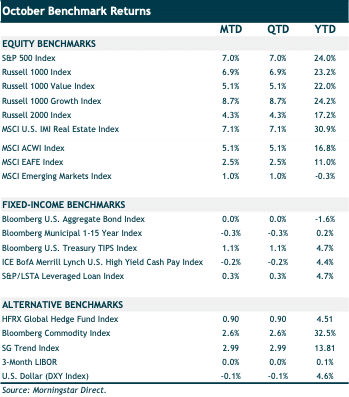NOVEMBER 2021 MARKET UPDATE
THE MONTH AT-A-GLANCE
- US stocks hit an all-time high in October as earnings season for many of the world’s largest companies kicks off.
- Core PCE, the Federal Reserve’s preferred inflation measure, came in at 3.64%, its fastest pace in 30 years.
- The US Treasury yield curve flattened in October, signaling investor concern about slowing future economic growth or inflation prints that result in sooner-than-expected rate hikes.
- In early November, the Federal Open Market Committee (FOMC) announced it will begin tapering its massive bond buying program.
MARKET RECAP
After falling in September, the S&P 500 Index rebounded in October to notch its best month of the year and finish at an all-time high. The S&P 500 gained 7.0% and the Russell 2000 Index (smaller-company stocks) returned 4.3%. The market was buoyed by strong third quarter earnings. According to BCA Research, nearly two-thirds of S&P 500 companies have now reported third quarter earnings and 83% of them have beaten Street earnings expectations. Not only that, nearly 77% of reporting companies have also beaten revenue expectations. Both numbers are well above long-term averages. However, two of the larger S&P 500 constituents did stumble. Apple and Amazon reported lower-than-expected revenue numbers, both citing supply-chain disruptions as headwinds for their businesses.
Foreign equity markets were positive in October but lagged US stocks. Developed international stocks (MSCI EAFE Index) returned 2.5%, while emerging-market stocks (MSCI Emerging Markets Index) posted a 1.0% gain. Concerns about China’s property sector eased slightly in the month after property developer Evergrande made coupon payments on its offshore bonds to help it stave off default. In the meantime, a handful of other Chinese property developers either defaulted or asked for a grace period on coupon payments in October. This led to a spike in yields on Chinese high-yield bonds—which touched nearly a 24% yield-to-maturity in mid-October before coming back down toward 20%. Investors have now shifted focus toward the potential for systemic impact and how the Chinese government might respond. The MSCI China Index gained 3.2% in October.
The yield curve flattened in October. The two-year US Treasury yield jumped to 0.48% from 0.28% in September. The 10-year rate also increased—however, it only moved up three basis points in the month to close at 1.55%. The longest end of the curve, the 30-year Treasury, actually decreased in October—going from 2.08% to 1.93%. The market is increasingly ratcheting up its expectations for rate hikes in 2022, which has pushed up the short end of the curve. According to CME futures data, there is currently a 76% probability that the Fed Funds Target Rate is 0.50%–0.75% (two 25-basis-point federal funds rate hikes) by the end of 2022. This is up from just a 27% probability at the beginning of October. And this can be compared to just half of FOMC members whose September dot plot indicated only one rate hike next year. On November 3, the FOMC announced it is beginning tapering of QE by $15 billion per month, with the expectation it will conclude by mid–2022. There is a growing narrative that the Fed may then immediately start to raise rates, despite Fed chair Jerome Powell saying there is no link between tapering and rate tightening. Core bonds (Bloomberg US Aggregate Bond Index) were flat in October and remain negative for the year (down 1.6%). The core bond index has not had a negative calendar year since 2013 (the year of the “taper tantrum”).
MARKET RECAP
After falling in September, the S&P 500 Index rebounded in October to notch its best month of the year and finish at an all-time high. The S&P 500 gained 7.0% and the Russell 2000 Index (smaller-company stocks) returned 4.3%. The market was buoyed by strong third quarter earnings. According to BCA Research, nearly two-thirds of S&P 500 companies have now reported third quarter earnings and 83% of them have beaten Street earnings expectations. Not only that, nearly 77% of reporting companies have also beaten revenue expectations. Both numbers are well above long-term averages. However, two of the larger S&P 500 constituents did stumble. Apple and Amazon reported lower-than-expected revenue numbers, both citing supply-chain disruptions as headwinds for their businesses.
Foreign equity markets were positive in October but lagged US stocks. Developed international stocks (MSCI EAFE Index) returned 2.5%, while emerging-market stocks (MSCI Emerging Markets Index) posted a 1.0% gain. Concerns about China’s property sector eased slightly in the month after property developer Evergrande made coupon payments on its offshore bonds to help it stave off default. In the meantime, a handful of other Chinese property developers either defaulted or asked for a grace period on coupon payments in October. This led to a spike in yields on Chinese high-yield bonds—which touched nearly a 24% yield-to-maturity in mid-October before coming back down toward 20%. Investors have now shifted focus toward the potential for systemic impact and how the Chinese government might respond. The MSCI China Index gained 3.2% in October.

The yield curve flattened in October. The two-year US Treasury yield jumped to 0.48% from 0.28% in September. The 10-year rate also increased—however, it only moved up three basis points in the month to close at 1.55%. The longest end of the curve, the 30-year Treasury, actually decreased in October—going from 2.08% to 1.93%. The market is increasingly ratcheting up its expectations for rate hikes in 2022, which has pushed up the short end of the curve. According to CME futures data, there is currently a 76% probability that the Fed Funds Target Rate is 0.50%–0.75% (two 25-basis-point federal funds rate hikes) by the end of 2022. This is up from just a 27% probability at the beginning of October. And this can be compared to just half of FOMC members whose September dot plot indicated only one rate hike next year. On November 3, the FOMC announced it is beginning tapering of QE by $15 billion per month, with the expectation it will conclude by mid–2022. There is a growing narrative that the Fed may then immediately start to raise rates, despite Fed chair Jerome Powell saying there is no link between tapering and rate tightening. Core bonds (Bloomberg US Aggregate Bond Index) were flat in October and remain negative for the year (down 1.6%). The core bond index has not had a negative calendar year since 2013 (the year of the “taper tantrum”).

